Nonlinear Response of Streamflow to Climate Change in High-Latitude Regions: A Case Study in Headwaters of Nenjiang River Basin in China’s Far Northeast
Abstract
:1. Introduction
2. Study Area and Methods
2.1. Study Area
2.2. Hydro-Meteorological Data
2.3. Ensemble Empirical Mode Decomposition
2.4. Application of EEMD to Hydro-Meteorological Data
3. Results
3.1. Nonlinear Variations of the Streamflow in HANR
3.2. Multiscale Response of Streamflow to Temperature Variations
3.3. Multiscale Response of Streamflow to Precipitation
3.4. Multiscale Response of Streamflow to ET0 Variations
4. Discussion
5. Conclusions
Acknowledgments
Author Contributions
Conflicts of Interest
References
- Donat, M.G.; Lowry, A.L.; Alexander, L.V.; O’Gorman, P.A.; Maher, N. More extreme precipitation in the world’s dry and wet regions. Nat. Clim. Chang. 2016, 6, 508–514. [Google Scholar] [CrossRef]
- Allen, M.R.; Ingram, W.J. Constraints on future changes in climate and the hydrologic cycle. Nature 2002, 419, 224–232. [Google Scholar] [CrossRef] [PubMed]
- Benda, L.; Hassan, M.A.; Church, M.; May, C.L. Geomorphology of steepland headwaters: The transition from hillslopes to channels. J. Am. Water Resour. Assoc. 2005, 41, 835–851. [Google Scholar] [CrossRef]
- Freeman, M.C.; Pringle, C.M.; Jackson, C.R. Hydrologic connectivity and the contribution of stream headwaters to ecological integrity at regional scales. J. Am. Water Resour. Assoc. 2007, 43, 5–14. [Google Scholar] [CrossRef]
- Wohl, E. The significance of small streams. Front. Earth Sci. 2017, 11, 447–456. [Google Scholar] [CrossRef]
- Gao, Y.; Vano, J.A.; Zhu, C.; Lettenmaier, D.P. Evaluating climate change over the colorado river basin using regional climate models. J. Geophys. Res.-Atmos. 2011, 116, D13104. [Google Scholar] [CrossRef]
- Bales, R.C.; Molotch, N.P.; Painter, T.H.; Dettinger, M.D.; Rice, R.; Dozier, J. Mountain hydrology of the western united states. Water Resour. Res. 2006, 42, W08432. [Google Scholar] [CrossRef]
- Zhang, A.; Liu, W.; Yin, Z.; Fu, G.; Zheng, C. How will climate change affect the water availability in the heihe river basin, northwest china? J. Hydrometeorol. 2016, 17, 1517–1542. [Google Scholar] [CrossRef]
- Baattrup-Pedersen, A.; Larsen, S.E.; Andersen, D.K.; Jepsen, N.; Nielsen, J.; Rasmussen, J.J. Headwater streams in the EU Water Framework Directive: Evidence-based decision support to select streams for river basin management plans. Sci. Total Environ. 2018, 613, 1048–1054. [Google Scholar] [CrossRef] [PubMed]
- Worqlul, A.W.; Taddele, Y.D.; Ayana, E.K.; Jeong, J.; Adem, A.A.; Gerik, T. Impact of climate change on streamflow hydrology in headwater catchments of the Upper Blue Nile Basin, Ethiopia. Water 2018, 10, 120. [Google Scholar] [CrossRef]
- Antico, A.; Schlotthauer, G.; Torres, M.E. Analysis of hydroclimatic variability and trends using a novel empirical mode decomposition: application to the Paraná River Basin. J. Geophys. Res. Atmos. 2014, 119, 1218–1233. [Google Scholar] [CrossRef]
- Xu, J.H.; Li, W.H.; Ji, M.H.; Lu, F.; Dong, S. A comprehensive approach to characterization of the nonlinearity of runoff in the headwaters of the Tarim River, western China. Hydrol. Process. 2010, 24, 136–146. [Google Scholar] [CrossRef]
- Bai, L.; Chen, Z.; Xu, J.; Li, W. Multi-scale response of runoff to climate fluctuation in the headwater region of Kaidu River in Xinjiang of China. Theor. Appl. Climatol. 2015, 125, 703–712. [Google Scholar] [CrossRef]
- Wu, Z.H.; Huang, N.E. Ensemble empirical mode decomposition: A noise-assisted data analysis method. Adv. Adapt. Data Anal. 2009, 1, 1–41. [Google Scholar] [CrossRef]
- Zhao, X.H.; Chen, X. Auto regressive and ensemble empirical mode decomposition hybrid model for annual runoff forecasting. Water Resour. Manag. 2015, 29, 2913–2926. [Google Scholar] [CrossRef]
- Ouyang, Q.; Lu, W.; Xin, X.; Zhang, Y.; Chen, W.G.; Yu, T. Monthly rainfall forecasting using EEMD-SVR based on phase-space reconstruction. Water Resour. Manag. 2016, 30, 2311–2325. [Google Scholar] [CrossRef]
- Lin, P.F.; Feng, X.L.; Liu, J.J. Historical trends in surface air temperature estimated by ensemble empirical mode decomposition and least squares linear fitting. Atmos. Ocean Sci. Lett. 2015, 8, 10–16. [Google Scholar]
- Franzke, C.L. Warming trends: Nonlinear climate change. Nat. Clim. Chang. 2014, 4, 423–424. [Google Scholar] [CrossRef]
- Sun, C.; Ma, Y. Effects of non-linear temperature and precipitation trends on loess plateau droughts. Quatern. Int. 2015, 372, 175–179. [Google Scholar] [CrossRef]
- Mao, T.; Wang, G.; Zhang, T. Impacts of climatic change on hydrological regime in the three-river headwaters region, China, 1960–2009. Water Resour. Manag. 2015, 30, 115–131. [Google Scholar] [CrossRef]
- Li, F.P.; Zhang, G.X.; Xu, Y.J. Spatiotemporal variability of climate and streamflow in the Songhua River Basin, northeast China. J. Hydrol. 2014, 514, 53–64. [Google Scholar] [CrossRef]
- Liu, Z.; Yang, X.; Chen, F.; Wang, E. The effects of past climate change on the northern limits of maize planting in Northeast China. Clim. Chang. 2013, 117, 891–902. [Google Scholar] [CrossRef]
- Feng, X.Q.; Zhang, G.X.; Yin, X. Hydrological responses to climate change in Nenjiang River Basin, northeastern China. Water Resour. Manag. 2011, 25, 677–689. [Google Scholar] [CrossRef]
- Tang, Y.; Wang, H.; Yan, D.H.; Tang, K.W. Evolutionary regularity of runoff of Nenjiang River Basin in period 1956–2000. Sci. Geogr. Sin. 2009, 29, 864–868. [Google Scholar]
- Dong, L.Q.; Zhang, G.X.; Xu, Y.J. Effects of climate change and human activities on runoff in the Nenjiang River Basin, Northeast China. Hydrol. Earth Syst. Sci. Disscuss. 2012, 9, 11521–11549. [Google Scholar] [CrossRef]
- Feng, X.Q.; Zhang, G.X.; Xu, Y.J. Simulation of hydrological processes in the Zhalong wetland within a river basin, Northeast China. Hydrol. Earth Syst. Sci. Disscuss. 2013, 17, 2797–2807. [Google Scholar] [CrossRef]
- Miao, C.; Yang, L.; Liu, B.; Gao, Y.; Li, S. Streamflow changes and its influencing factors in the mainstream of the Songhua River basin, Northeast China over the past 50 years. Environ. Earth Sci. 2011, 63, 489–499. [Google Scholar] [CrossRef]
- Han, T.; Chen, H.; Wang, H. Recent changes in summer precipitation in Northeast China and the background circulation. Int. J. Climatol. 2015, 35, 4210–4219. [Google Scholar] [CrossRef]
- Liu, Y.; Ren, L.; Yang, X.; Ma, M.; Yuan, F.; Jiang, S. Effects of precipitation and potential evaporation on actual evapotranspiration over the Laohahe basin, northern China. Proc. Int. Assoc. Hydrol. Sci. 2015, 371, 173–179. [Google Scholar] [CrossRef]
- Allen, R.G.; Pereira, L.S.; Raes, D.; Smith, M. Crop Evapotranspiration-Guidelines for Computing Crop Water Requirements-FAO Irrigation and Drainage Paper 56; Food and Agriculture Organization of the United Nations (FAO): Rome, Italy, 1998; Volume 300, p. D05109. [Google Scholar]
- Wu, Z.H.; Huang, N.E.; Long, S.R.; Peng, C.K. On the trend, detrending and variability of nonlinear and non-stationary time series. Proc. Nat. Acad. Sci. USA 2007, 104, 14889–14894. [Google Scholar] [CrossRef] [PubMed]
- Harvey, D.I.; Leybourne, S.J.; Taylor, A.M.R. On infimum Dickey–Fuller unit root tests allowing for a trend break under the null. Comput. Stat. Data Anal. 2014, 78, 235–242. [Google Scholar] [CrossRef]
- Sang, Y.F.; Wang, Z.; Liu, C. Comparison of the MK test and EMD method for trend identification in hydrological time series. J. Hydrol. 2014, 510, 293–298. [Google Scholar] [CrossRef]
- Yu, X.Y.; He, X.Y.; Zheng, H.F.; Guo, R.C.; Ren, Z.B.; Zhang, D.; Lin, J.X. Spatial and temporal analysis of drought risk during the crop-growing season over northeast China. Nat. Hazard. 2014, 71, 275–289. [Google Scholar] [CrossRef]
- Leauthaud, C.; Duvail, S.; Hamerlynck, O.; Paulc, J.; Cochete, H.; Nyunjaf, J.; Albergela, J.; Grünbergera, O. Floods and livelihoods: The impact of changing water resources on wetland agro-ecological production systems in the Tana River Delta, Kenya. Glob. Environ. Chang. 2013, 23, 252–263. [Google Scholar] [CrossRef]
- Yuan, L.H.; Jiang, W.G.; Luo, Z.L.; He, X.H.; Liu, Y.H. Analysis of wetland change in the Songhua River Basin from 1995 to 2008. IOP Conf. Ser. Earth Environ. Sci. 2014, 17, 12125–12131. [Google Scholar] [CrossRef]
- Niu, Z.G.; Zhang, H.Y.; Wang, X.W.; Yao, W.B.; Zhou, D.M.; Zhao, K.Y.; Zhao, H.; Li, N.N.; Huang, H.B.; Li, C.C.; et al. Mapping wetland changes in China between 1978 and 2008. Chin. Sci. Bull. 2012, 57, 2813–2823. [Google Scholar] [CrossRef]
- Li, F.P.; Zhang, G.X.; Xu, Y.J. Assessing climate change impacts on water resources in the Songhua River Basin. Water 2016, 8, 420. [Google Scholar] [CrossRef]
- Piao, S.; Ciais, P.; Huang, Y.; Shen, Z.H.; Peng, S.S.; Li, J.S.; Zhou, L.P.; Liu, H.Y.; Ma, Y.C.; Ding, Y.H.; et al. The impacts of climate change on water resources and agriculture in China. Nature 2010, 467, 43–51. [Google Scholar] [CrossRef] [PubMed]
- Song, X.Y.; Li, L.J.; Fu, G.B.; Li, J.Y.; Zhang, A.J.; Liu, W.B.; Zhang, K. Spatial–temporal variations of spring drought based on spring-composite index values for the Songnen Plain, Northeast China. Theor. Appl. Climatol. 2014, 116, 371–384. [Google Scholar] [CrossRef]
- Spence, C.; Guan, X.J.; Phillips, R.; Hedstrom, N.; Granger, R.; Reid, B. Storage dynamics and streamflow in a catchment with a variable contributing area. Hydrol. Process 2010, 24, 2209–2221. [Google Scholar] [CrossRef]
- López-Moreno, J.I.; Zabalza, J.; Vicente-Serrano, S.M.; Revuelto, J.; Gilaberte, M.; Azorin-Molina, C.; Morán-Tejeda, E.; García-Ruiz, J.M.; Tague, C. Impact of climate and land use change on water availability and reservoir management: Scenarios in the Upper Aragón River, Spanish Pyrenees. Sci. Total Environ. 2014, 493, 1222–1231. [Google Scholar] [CrossRef] [PubMed]
- Li, R.; Zheng, H.; Lv, S.; Liao, W.; Lu, F. Development and evaluation of a new index to assess hydrologic regulating service at sub-watershed scale. Ecol. Indic. 2018, 86, 9–17. [Google Scholar] [CrossRef]
- Kelly, C.N.; Mcguire, K.J.; Miniat, C.F.; Vose, J.M. Streamflow response to increasing precipitation extremes altered by forest management. Geophys. Res. Lett. 2016, 43, 3727–3736. [Google Scholar] [CrossRef]
- Fossey, M.; Rousseau, A.N. Can isolated and riparian wetlands mitigate the impact of climate change on watershed hydrology? A case study approach. J. Environ. Manag. 2016, 184, 327–339. [Google Scholar] [CrossRef] [PubMed]
- Whigham, D.F.; Walker, C.M.; Maurer, J.; Kingc, R.S.; Hausera, W.; Bairdb, S.; Keuskampe, J.A.; Nealea, P.J. Watershed influences on the structure and function of riparian wetlands associated with headwater streams–Kenai Peninsula, Alaska. Sci. Total Environ. 2017, 599–600, 124–134. [Google Scholar] [CrossRef] [PubMed]
- Liu, J.; Hayakawa, N.; Lu, M.; Dong, S.; Yuan, J. Hydrological and geocryological response of winter streamflow to climate warming in Northeast China. Cold Reg. Sci. Technol. 2003, 37, 15–24. [Google Scholar] [CrossRef]
- Liu, J.; Hayakawa, N.; Lu, M.; Dong, S.; Yuan, J. Winter streamflow, ground temperature and active-layer thickness in northeast China. Permafr. Periglac. Process. 2003, 14, 11–18. [Google Scholar] [CrossRef]
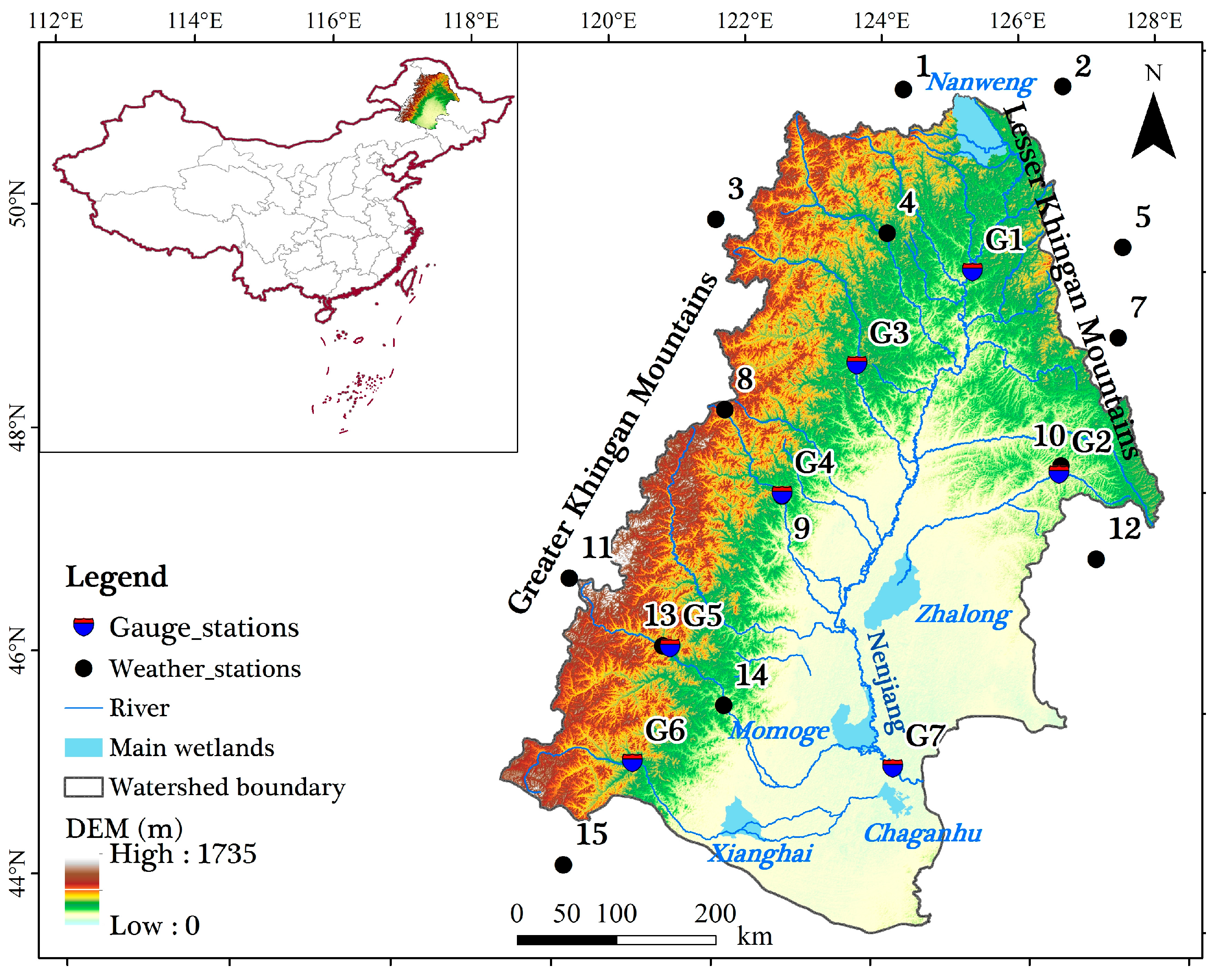
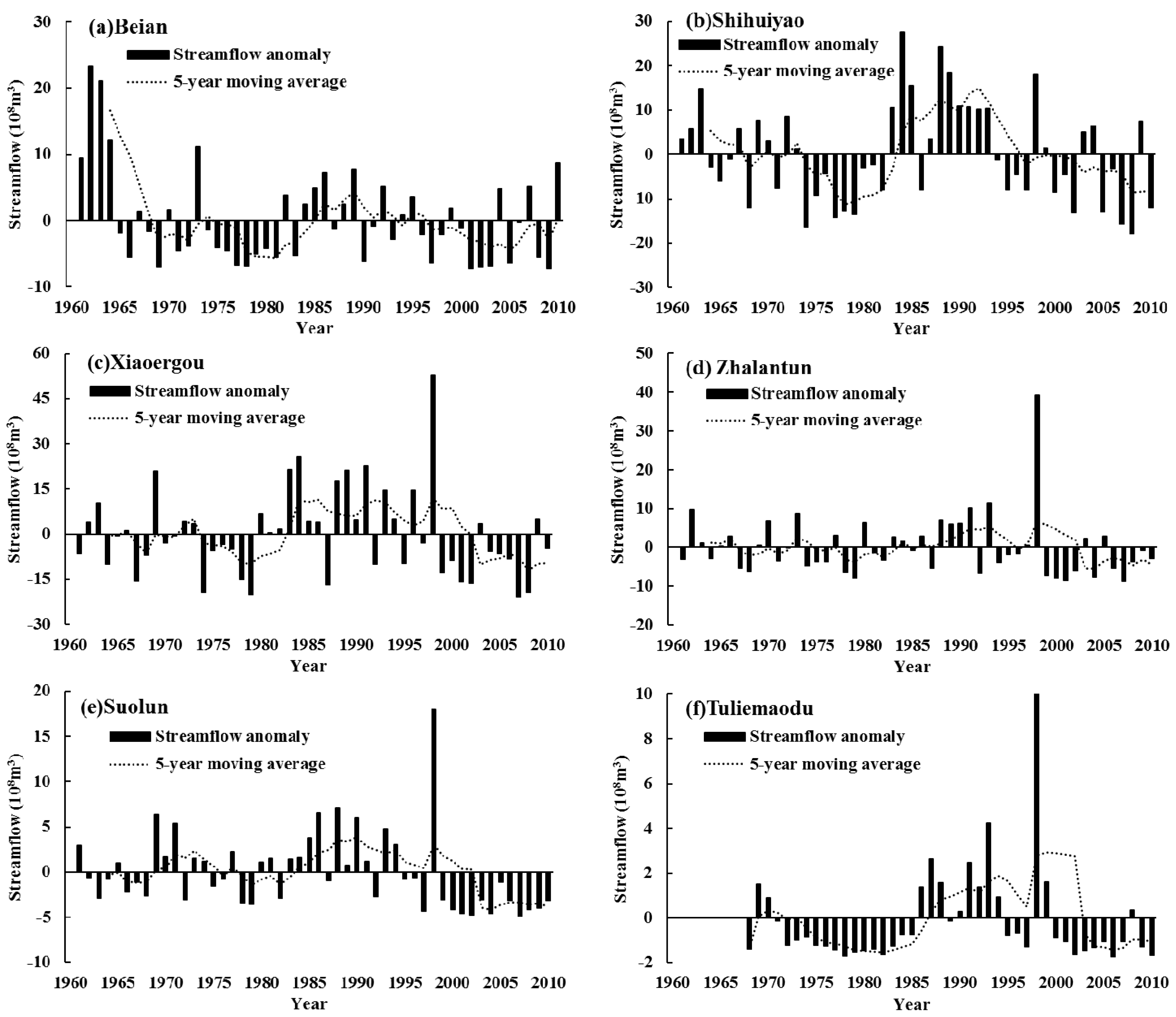

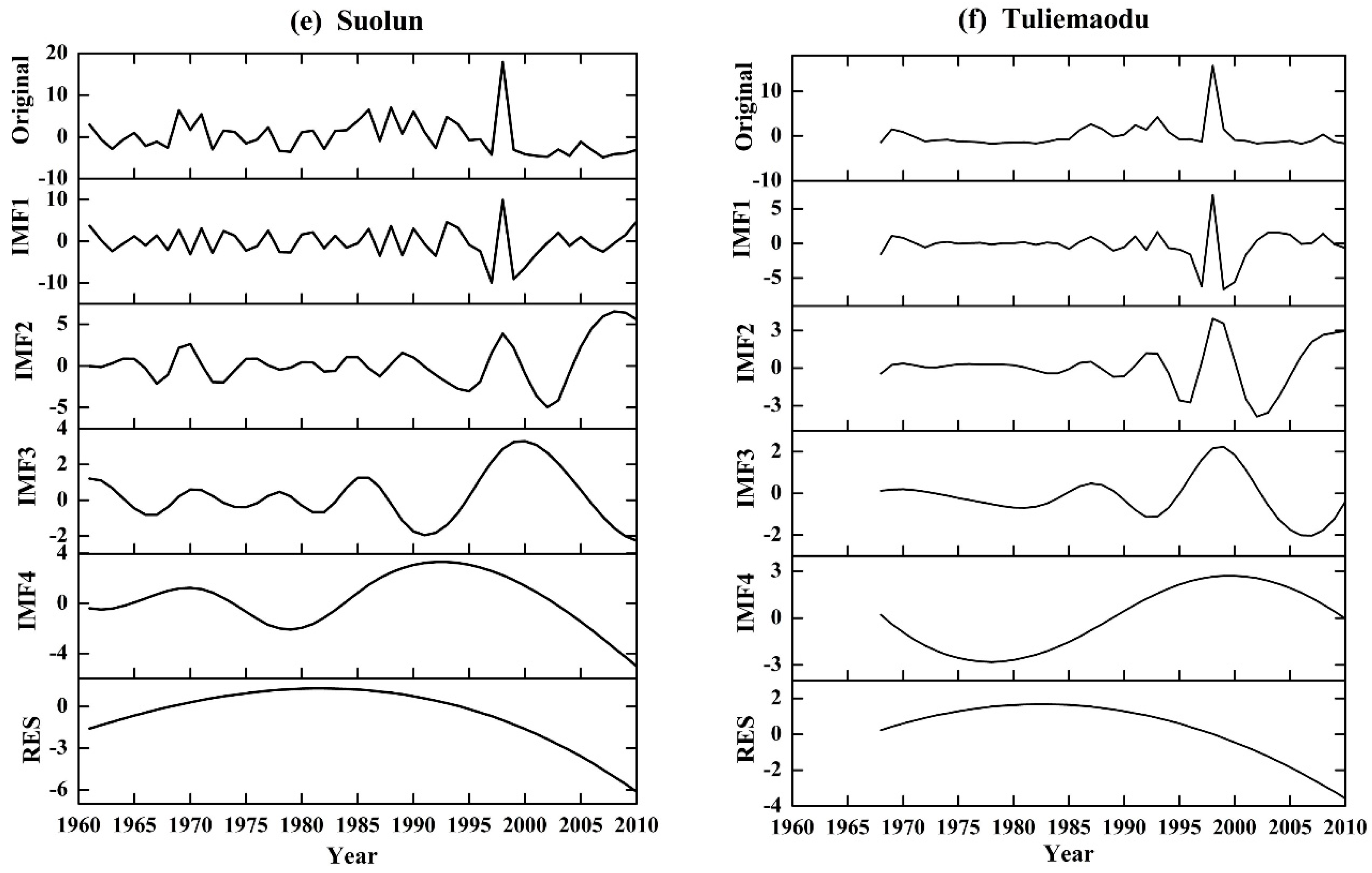

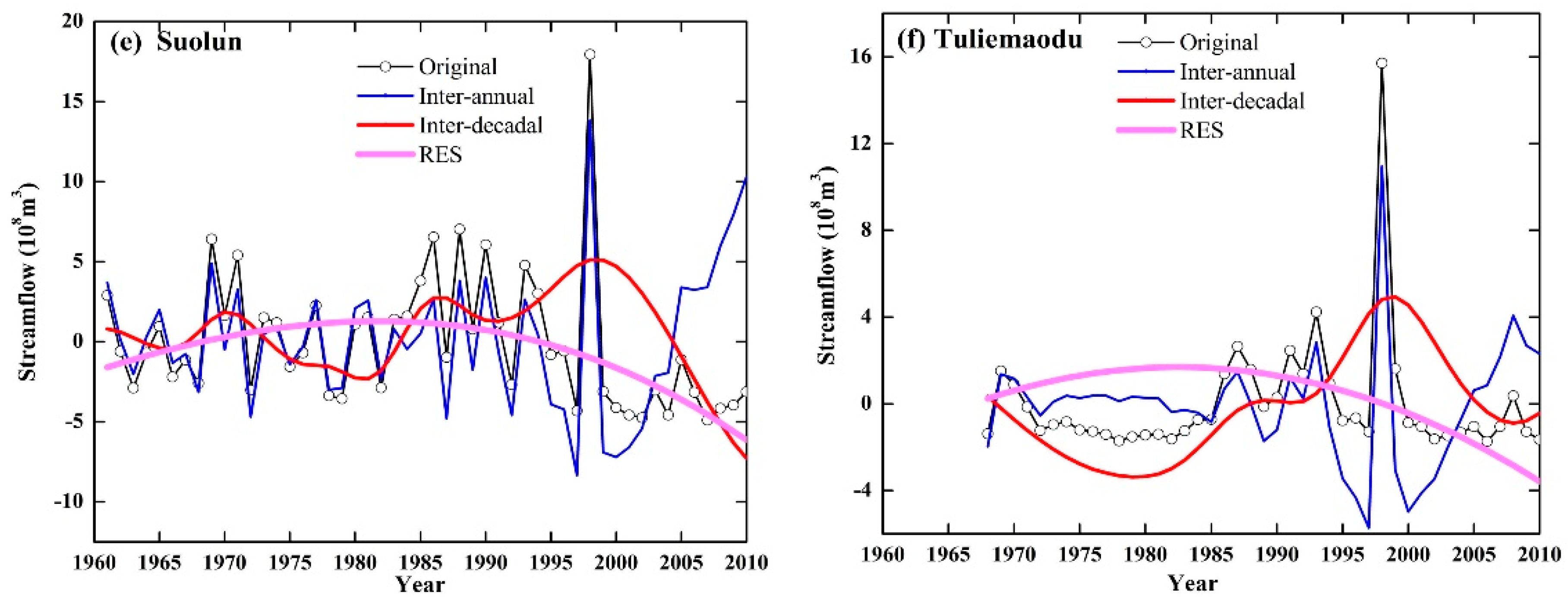
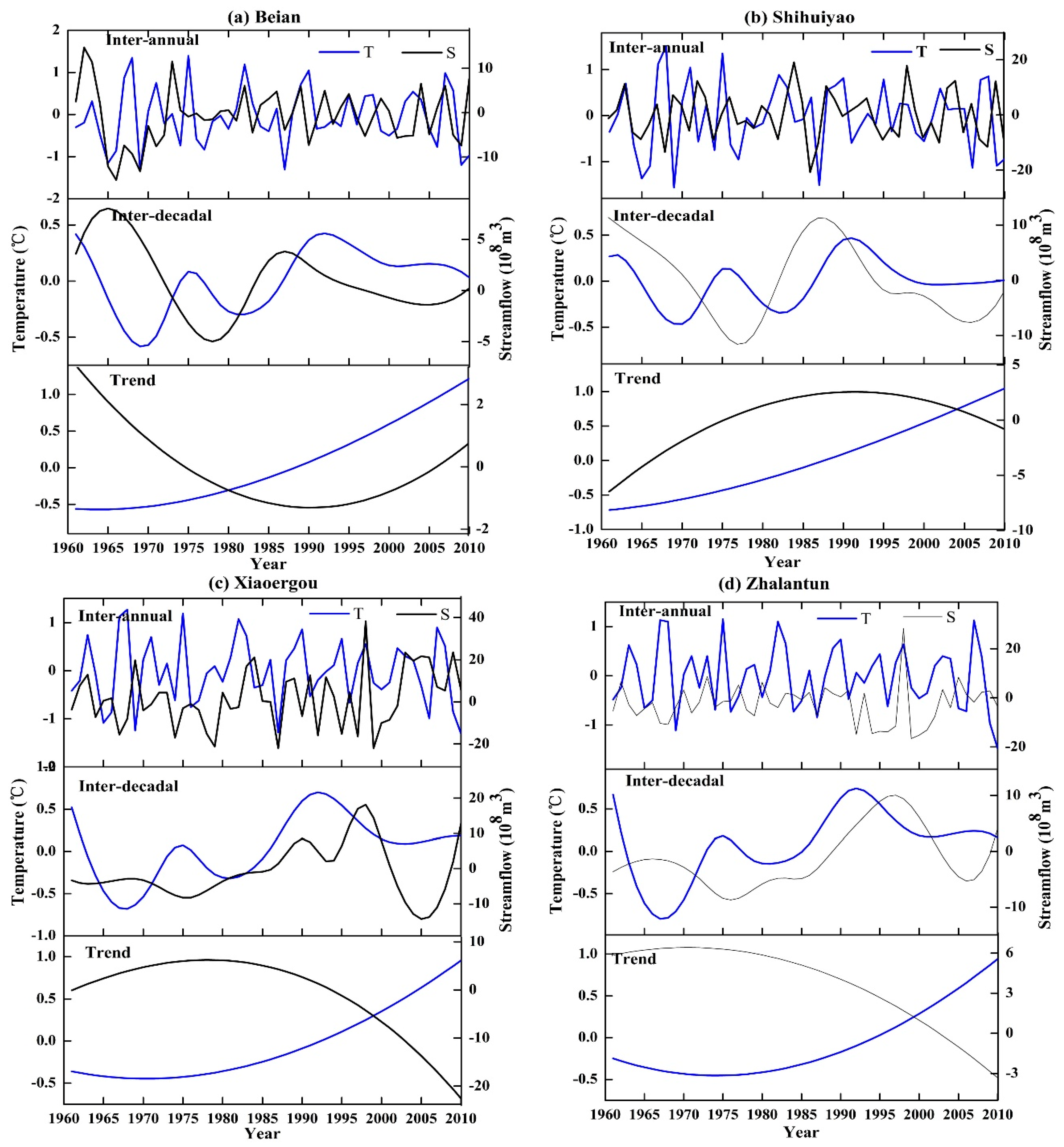
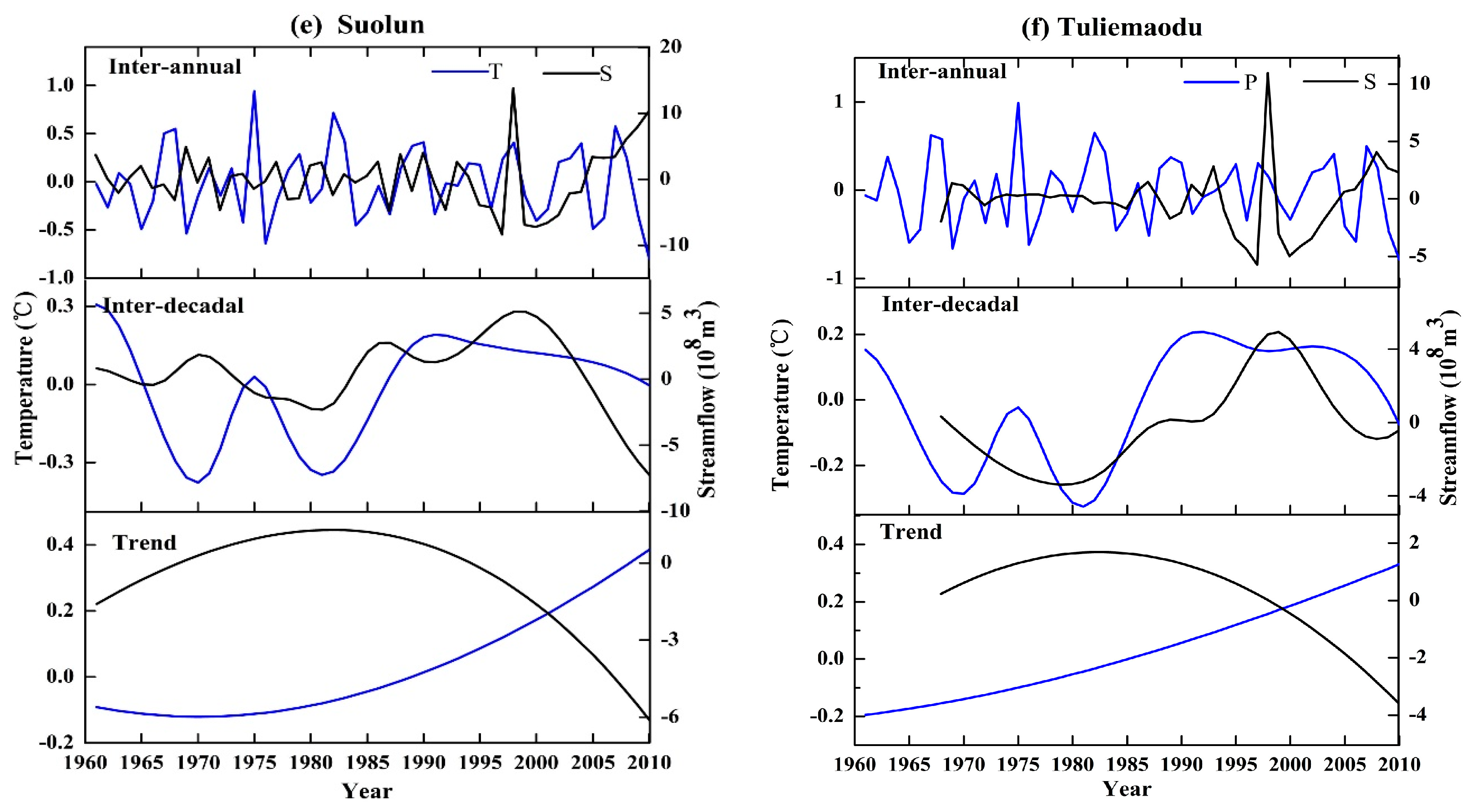

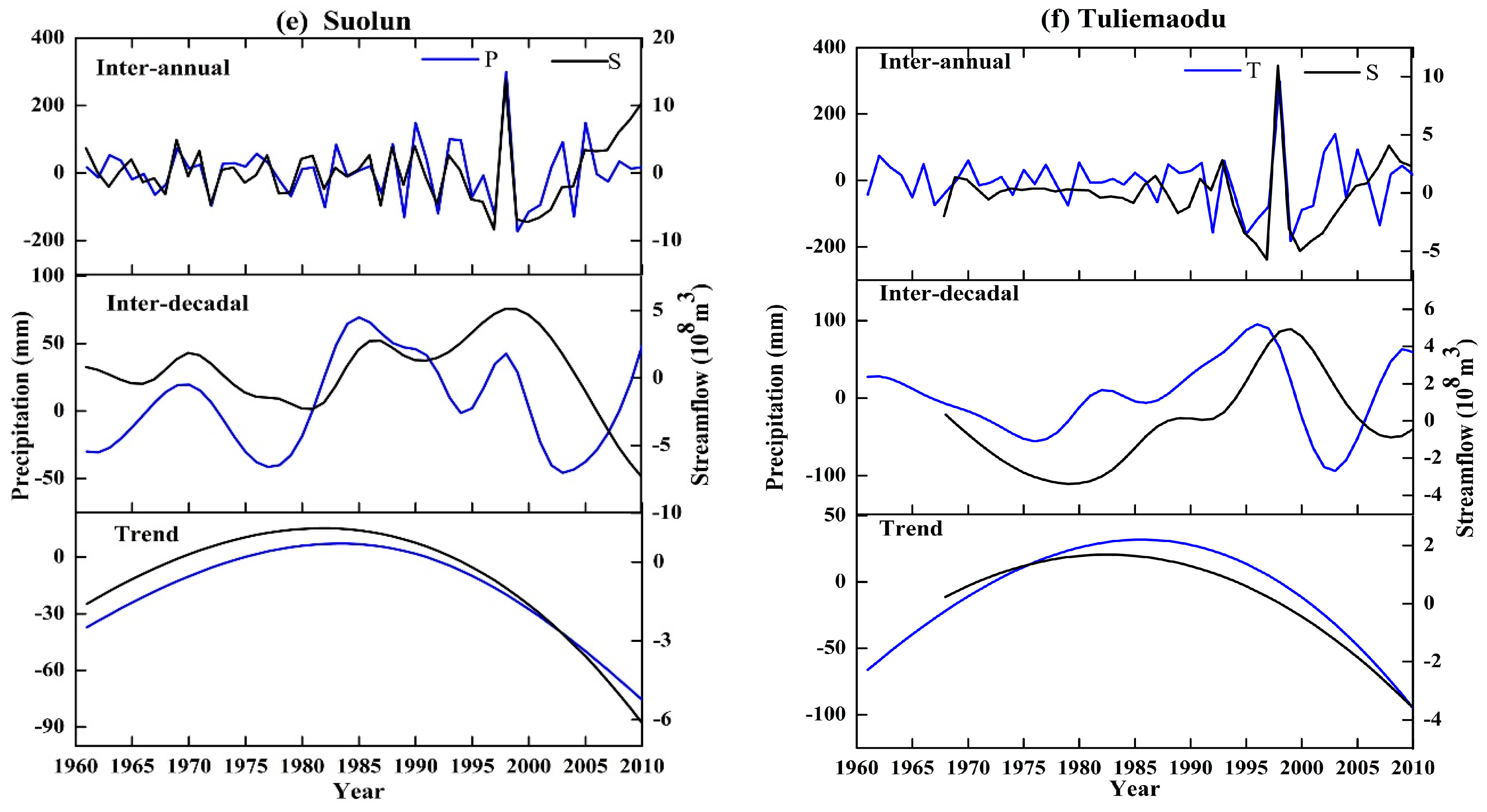
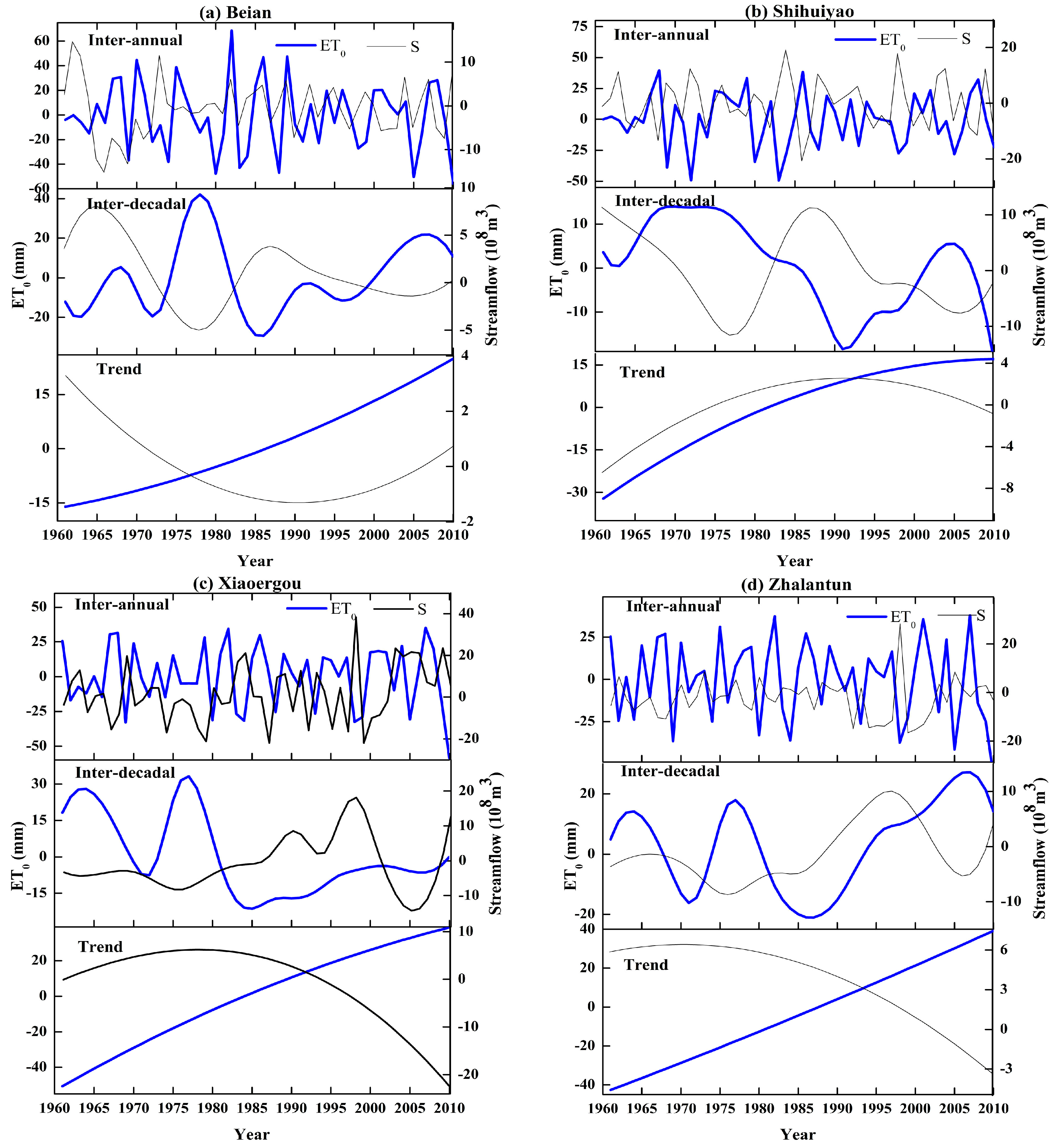
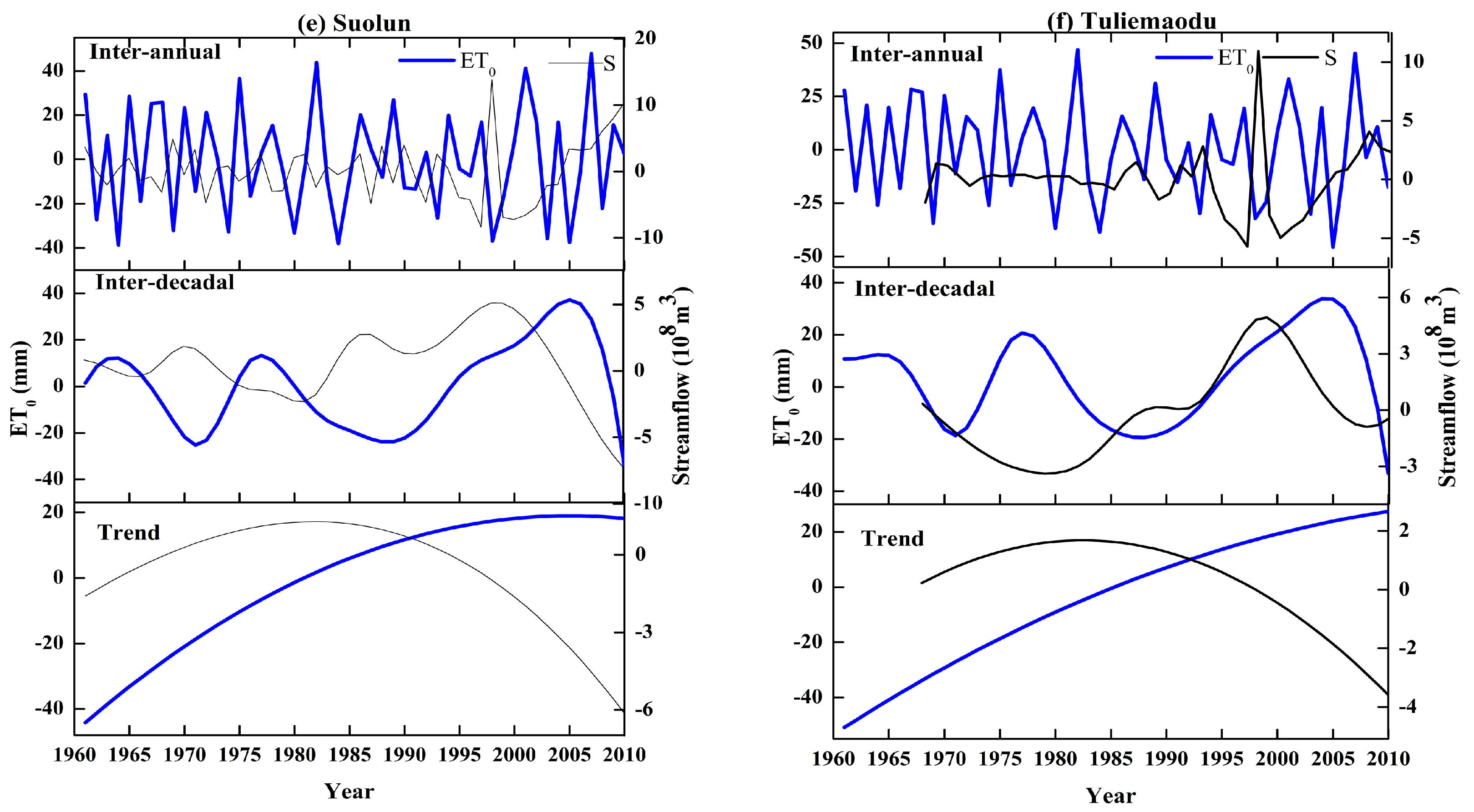
| No. | Gauge Stations | Basin | Time Span | DA (km2) | AS (108 m3) | MS No. |
|---|---|---|---|---|---|---|
| G1 | Shihuiyao | Mainstream | 1961–2010 | 17,205 | 27.16 | 1, 2, 4, 5 |
| G2 | Beian | Wuyuer River | 1961–2010 | 2952 | 2.75 | 7, 10, 12 |
| G3 | Xiaoergou | Nuomin River | 1961–2010 | 16,761 | 30.55 | 3, 4, 6, 8 |
| G4 | Zhalantun | Yalu River | 1961–2010 | 6891 | 9.61 | 8, 9 |
| G5 | Suolun | Taoer River | 1961–2010 | 5893 | 5.63 | 11, 13 |
| G6 | Tuliemaodu | Huolin River | 1961–2010 | 8000 | 2.56 | 11, 13, 14, 15 |
| G7 | Dalai | Mainstream | 1968–2010 | 221,715 | 214.25 | / |
| Gauge Stations | T (°C) | P (mm) | ET0 (mm) | S (108 m3) | ||||
|---|---|---|---|---|---|---|---|---|
| Inter-Annual | Inter-Decadal | Inter-Annual | Inter-Decadal | Inter-Annual | Inter-Decadal | Inter-Annual | Inter-Decadal | |
| Beian | 3.50 | 16.33 | 3.27 | 12.25 | 3.06 | 12.25 | 3.50 | 24.50 |
| Shihuiyao | 3.27 | 16.33 | 3.06 | 16.33 | 3.06 | 24.50 | 3.06 | 24.50 |
| Xiaoergou | 3.76 | 16.33 | 3.06 | 12.25 | 3.06 | 16.33 | 3.26 | 16.33 |
| Zhalantun | 3.50 | 16.33 | 3.06 | 12.25 | 3.06 | 16.33 | 3.27 | 16.33 |
| Suolun | 3.50 | 16.33 | 2.88 | 16.33 | 2.88 | 16.33 | 3.26 | 16.33 |
| Tuliemaodu | 3.76 | 16.33 | 3.27 | 16.33 | 2.88 | 16.33 | 3.82 | 21.00 |
| Gauge Stations | T (°C) | P (mm) | ET0 (mm) | S (108 m3) | ||||
|---|---|---|---|---|---|---|---|---|
| Tre | TraY | Trend | TraY | Trend | TraY | Trend | TraY | |
| Beian | Strong Rising | / | Strong decreasing-slight rising | 1997 | Strong Rising | / | Strong decreasing-slight rising | 1990 |
| Shihuiyao | Strong Rising | / | Strong rising-slight decreasing | 1998 | Strong Rising | / | Strong rising-slight decreasing | 1991 |
| Xiaoergou | Slight decreasing-strong rising | 1970 | Slight rising-strong decreasing | 1986 | Strong Rising | / | Slight rising-strong decreasing | 1982 |
| Zhalantun | Slight decreasing-strong rising | 1974 | Strong rising-strong decreasing | 1986 | Strong Rising | / | Slight rising-strong decreasing | 1970 |
| Suolun | Slight decreasing-strong rising | 1970 | Slight rising-strong decreasing | 1983 | Strong Rising-slight decreasing | 2005 | Slight rising-strong decreasing | 1992 |
| Tuliemaodu | Strong Rising | - | Strong rising-strong decreasing | 1988 | Strong Rising | / | Slight rising-strong decreasing | 1984 |
© 2018 by the authors. Licensee MDPI, Basel, Switzerland. This article is an open access article distributed under the terms and conditions of the Creative Commons Attribution (CC BY) license (http://creativecommons.org/licenses/by/4.0/).
Share and Cite
Wu, Y.; Zhang, G.; Shen, H.; Xu, Y.J. Nonlinear Response of Streamflow to Climate Change in High-Latitude Regions: A Case Study in Headwaters of Nenjiang River Basin in China’s Far Northeast. Water 2018, 10, 294. https://doi.org/10.3390/w10030294
Wu Y, Zhang G, Shen H, Xu YJ. Nonlinear Response of Streamflow to Climate Change in High-Latitude Regions: A Case Study in Headwaters of Nenjiang River Basin in China’s Far Northeast. Water. 2018; 10(3):294. https://doi.org/10.3390/w10030294
Chicago/Turabian StyleWu, Yanfeng, Guangxin Zhang, Hong Shen, and Y. Jun Xu. 2018. "Nonlinear Response of Streamflow to Climate Change in High-Latitude Regions: A Case Study in Headwaters of Nenjiang River Basin in China’s Far Northeast" Water 10, no. 3: 294. https://doi.org/10.3390/w10030294





